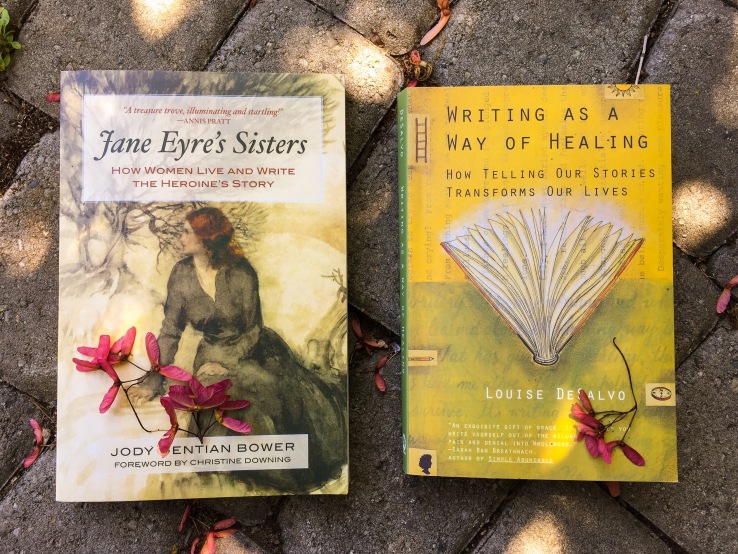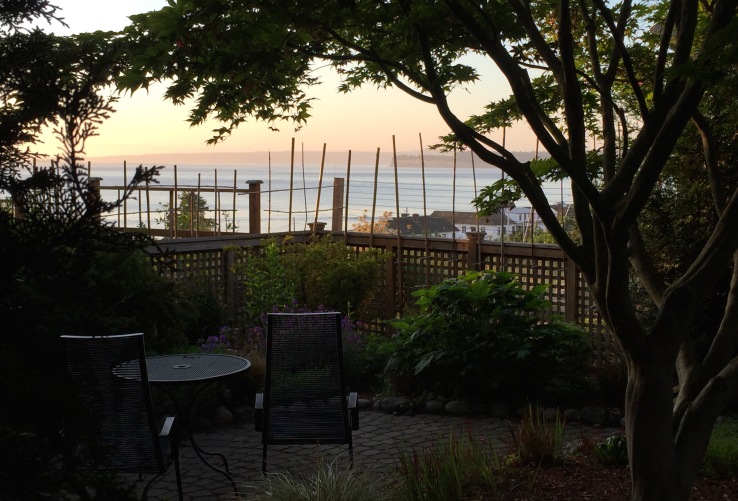
About the creative life and writing memoir…
“I didn’t know that if you want to write and don’t, because you don’t feel worthy enough or able enough, not writing will eventually begin to erase who you are.”
“What if writing were as important as a basic human function and as significant to maintaining and promoting our psychic and physical wellness as, say, exercise, healthful food, pure water, clean air, rest and repose, and some soul-satisfying practice?”
“This book is an invitation for you to use the simple act of writing as a way of reimagining who you are or remembering who you were.” – Louise DeSalvo
When I was staying in Port Townsend, I picked up a copy of Louise DeSalvo’s book, Writing As a Way of Healing, at The Writers’ Workshoppe and Imprint Bookstore.
I’d heard DeSalvo speak at a free National Association of Memoir Writers teleseminar, and she was fantastic. (The founder of NAMW is my wonderful writing coach, Linda Joy Myers, who does an outstanding job connecting the best memoir writers and teachers with those of us trying to make our way through the wilderness of writing our own memoirs.)
I would say if you are writing a memoir, a novel, or any long-form work of nonfiction, or if you want to write about your life as a form of self-expression, this book is a must-read, a valuable companion to have at your side at all times while you work. DeSalvo’s voice is warm, wise, encouraging, and firm. She’ll help you develop a common sense writing practice that is less of a struggle and more intentional, self-caring, and restorative.
One of DeSalvo’s key points is that writing your story is healing and transformative, but only if you go about it the right way. As a medical librarian, I’m all for looking at what the scientific research has to say before making a claim about anything, and DeSalvo does just that.
We’ve all heard that writing can be healing, but simply venting emotions on the page may cause a writer to get stuck or even set the writer back. On the other hand, telling what happened in a dispassionate way – a mere listing of events – won’t do much, either.
Writers need to do both – honestly tell about events and honestly recount their emotions – and link them in a meaningful way. “A healing narrative links feelings with events.”
Research has shown that only when a person tells what happened with honesty, nuance, and detail that includes not just events, but feelings, and with the intention of unearthing and crafting a true, meaningful story – only then does writing about one’s life hold the possibility of transformation.
This is not easy. It requires honest self-evaluation and facing aspects of yourself you may have kept hidden. It requires putting yourself in the place of others so you can understand why they may have behaved in certain ways.
Vivid characterization, dialogue reconstructed to the best of your ability, movie-like scenes that highlight key events and emotional peaks and valleys, all woven into a narrative, is a lot of work, but it’s a way to re-experience life events that can bring catharsis, insight, and meaning.
DeSalvo points to research that suggests people who recall traumatic events in a vague, general way – without detail or nuance – have not yet begun the healing process. I was amazed when I read this, because my first drafts tend to be frustratingly superficial. As a child and adolescent, I’d numbed out to protect myself and, as an adult, to avoid grappling with painful events. Writing about them now often requires several drafts as I gradually mine through to the essentials of the experience. I thought this was a sign that I was a mediocre writer. DeSalvo helped me understand that this is a normal part of the healing and writing process.
Even though I haven’t finished writing my memoir, I’ve already reaped benefits. Writing about events that are emotionally difficult or that arouse shame indeed lose their repressive power over me once they are on the page.
Honoring people’s privacy is also a concern that can hold writers back, but DeSalvo encourages us to remember we are writing a draft, and that these issues can be carefully considered later, if we want to publish. At that time, we can make revisions to protect privacy.
She reminds us, too, that there is a lot to be said for public testimony (in a way that doesn’t harm others) about trauma and issues that society has pressured many of us to keep silent about. In the case of mental illness, for example, no one is healed and nothing can improve unless long-avoided issues are brought into the light of day and confronted.
For me, DeSalvo’s book is most valuable because she has given me a way to write a memoir without losing my mind. She breaks down the process into phases and walks me through each one: Preparing, Planning, Germinating, Working, Deepening, Shaping, Ordering, and Completing.
Not every phase is pleasurable, and if we have difficulty, we aren’t to blame ourselves, but persist. It’s just part of the process. We learn what we can realistically expect in each phase, which greatly reduces anxiety.
I’m still learning how to integrate writing into my everyday life so it becomes habitual, manageable, and enjoyable. I’m still learning how to care for myself as I write – for example, by writing in short, frequent doses so I’m not overwhelmed emotionally and by judiciously sharing my writing only with those who support my work and have some understanding of the rigors of the process.
I should add that, as I’ve excavated my life and the effects of my mother’s mental illness on our family over the years, I’ve had the help of an excellent therapist. DeSalvo encourages writers to connect with a good therapist if they’re having difficulties. Writing is not a substitute for therapy. She says: “I personally believe it is essential for people wanting to write about extreme situations to have skilled professional support while writing or to attend a reputable support group.”
There is so much more to this book. DeSalvo draws on the wisdom of psychologists, researchers, and well-known writers, integrating their knowledge into a compelling and enormously helpful guide.
Many, many passages in my copy of Writing As a Way of Healing are underlined. Here are a few:
“Sometimes the writer is unsure about precisely what happened because…she or he was in a state of shock or emotional numbness while it was happening. The most basic and important survival tactics often involve blunting the emotions, carefully watching, splitting the consciousness (watching the event as if it’s happening to someone else), even splitting the self (into two or more personae). Finding words, finding literary forms to convey these self-preserving defensive tactics, these superlinguistic layers of meaning, often seems impossible.”
“Virginia Woolf said moments of profound insight that come from writing about our soulful, thoughtful examination of our psychic wounds should be called ‘shocks.’ For they force us into an awareness about ourselves and our relationship to others and our place in the world that we wouldn’t otherwise have had. They realign the essential nature of our being.”
“In time, I learned how Zen artists and writers devote themselves to an orderly, contemplative way of life that prepares them for their work. But how doing their work, too, becomes a form of meditation. Work and life are deeply integrated.”
A quote by Henry Miller:“[Writing] lifts the sufferer out of his obsessions and frees him for the rhythm and movement of life by joining him to the great universal stream in which we all have our being.”
Note: After reading this post, my dear writing coach, Linda Joy, tried to leave a comment, but either WordPress or my comment settings didn’t allow her to. So I’m putting her words here, which I greatly appreciate:
What a wonderful essay about the essentials in writing memoir and narrating our truths. I have loved Louise DeSalvo’s book for years and was so happy when she joined us for two NAMW presentations last year! I also got the other books, Jane Eyre’s Sisters thanks to you Valorie, and love it. It offers a more accurate template for the heroine’s story, which is necessarily an internal journey, not just an external one. Thank you for illuminating these gems and what you find valuable in your lovely blog! – Linda Joy Myers
Thank you, Linda Joy.
Below are photos of Port Townsend, where I did some writing and read Louise DeSalvo’s book. Nature is a wonderful restorative when you’re writing memoir.
(By the way, the photo above shows Jane Eyre’s Sisters, which I also picked up at The Writer’s Workshoppe and Imprint Bookstore. I’m still making my way through it. Jane Eyre has a role to play in my memoir.)










Thanks for the wonderful overview of “Writing as a Way of Healing.” You’ve inspired me to seek out a copy. I listened today to your “Water Bewitched” audio essay at Terrain.org and really enjoyed it.
I’m so glad you stopped by! I think you will like the book, and thank you for the audio essay thumbs up!
ciao Valory
________________________________ Da: Books Can Save A Life Inviato: giovedì 30 giugno 2016 20.48 A: pinosansone@live.it Oggetto: [New post] Excavating a Life
Valorie Grace Hallinan posted: ” About the creative life and writing memoir… Writing As a Way of Healing: How Telling Our Stories Transforms Our Lives by Louise DeSalvo “I didn’t know that if you want to write and don’t, because you don’t feel worthy enough or able enough, not writ”
Ciao Giuseppe!
I love the image of the Bazaar Girls at their shop, “crafting community” from their yarn and each other.
I loved that shop. I spent quite a while in there because the yarns were beautiful and amazing to touch, the finished pieces were gorgeous, and there were women working and crafting at a table – I enjoyed talking with them and seeing them work.
“Not writing can erase who you are” is such a profound statement, which I firmly believe. I have journaled all my life, not being what I would consider truly a writer, and it has helped me so much in sorting out my heart, my position, my plans. It has helped in forgiveness and hope and all kinds of lessons. This was a beautiful, and necessary, post.
I’m sorry I didn’t put the quote accurately; I got all caught up in my thoughts for the comment. And, your pictures, as always, are lovely.
Thanks. Regardless, that is such a powerful concept of erasure, I can see why it caught your attention like it did mine. I’m glad you liked the pictures!
Thank you for your kind words, I appreciate them. Yes, I found the idea of “erasing who you are” powerful too, and so true.
I am instituting a FB “Like”. I read you column every week and although I almost never have an insightful cimment, I think I should be able to say “Like”!
Thanks, Linda!
How lovely that Jane Eyre has a role to play in your memoir. Good luck writing. Great pics too.
Thank you Resh!
Did not writing begin to erase Elena’s brilliant friend, Lila? Mi chiedo…
Certo!